
Features
Operations
High Expectations
In 2005, Brazilian aircraft manufacturer Embraer set out to design and build what it called a revolutionary entry-level jet. It promised that this new aircraft would feature premium comfort, outstanding performance, docile flying qualities and low operating costs.
September 29, 2009 By Stacy Bradshaw
In 2005, Brazilian aircraft manufacturer Embraer set out to design and build what it called a revolutionary entry-level jet. It promised that this new aircraft would feature premium comfort, outstanding performance, docile flying qualities and low operating costs.
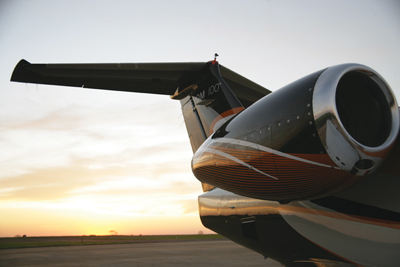 |
|
At the time the project was launched, the business aviation landscape was littered with announcements and pronouncements heralding the birth of one, then another, VLJ and for a while it looked like there would be no end to the folly. Now, more than four years later, the term “VLJ” has been all but expunged from the lexicon of business aviation and the number of entry-level business jet manufacturers has been drastically and mercifully reduced.
The Phenom 100 is a clean sheet aircraft that was conceived, developed, and certified in less than four years. The birth of this entry-level jet and its sibling, the Phenom 300, can be traced back to the year 2000, when Embraer launched its Legacy 600 project. At the time of the announcement, the company articulated the goal of becoming one of the biggest manufacturers in the business jet segment. Since then, Embraer has steadfastly pursued that goal, with the introduction of the Legacy 500, 450 and the Lineage 1000. The company has set a target date of 2015, when it will have six business jets being manufactured, covering practically all of the segments of executive aviation.
Delivering airplanes is nothing new for Embraer, the world’s fourth largest aircraft manufacturer, but the development of the Phenom 100 has had a special significance. The aircraft is the first jet to be designed by Embraer exclusively for the executive market. (Both the Legacy 600 and the Lineage 1000 are based on commercial jet platforms.)
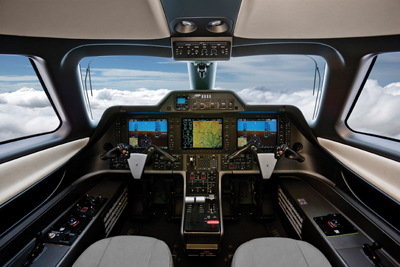 |
|
| The Prodigy flight deck features FMS with graphical flight planning capability, integrated EICAS and main-system synoptics.
|
Throughout its development, the Phenom 100 program remained pretty much on schedule, with aircraft number 99801 becoming airborne for the first time on July 26, 2007. Some minor delays took place in the late summer and fall of 2008, but in December 2008 Embraer received its Type Certificate from Brazil’s National Civil Aviation Authority (Agência Nacional de Aviação Civil – ANAC) at Embraer headquarters in São José dos Campos.
The FAA granted U.S. Type Certificate, based upon Brazil’s National Civil Aviation Agency’s Type Certificate, three days later and deliveries began the following week. (Since then, EASA certification was granted in April 2009, and Australian CASA certification in August 2009.)
Certification saw the aircraft surpass several performance goals. The Phenom 100’s maximum range, originally projected to be 1,160 nautical miles (2,148 kilometres or 1,335 miles), was extended to 1,178 nautical miles (2,182 kilometres or 1,356 miles) with four occupants and NBAA IFR reserves.
An optional enhanced take-off performance package was included in the aircraft certification, resulting in a 3,125 ft. take-off field length at maximum take-off weight. The standard take-off field length is 3,400 ft. as initially specified.
For departures from airports with restrictions due to high temperatures or high elevations, or both, take-off climb performance also surpassed the design target, providing up to 300 nautical miles extra range. Another performance improvement was achieved with the landing distance, verified to be only 2,699 feet at maximum landing weight, 301 feet shorter than initially specified.
Powered by two Pratt & Whitney Canada PW617F-E engines, the Phenom 100’s fuel consumption was confirmed to be better than originally estimated, saving as much as 3.6 per cent on longer trips.
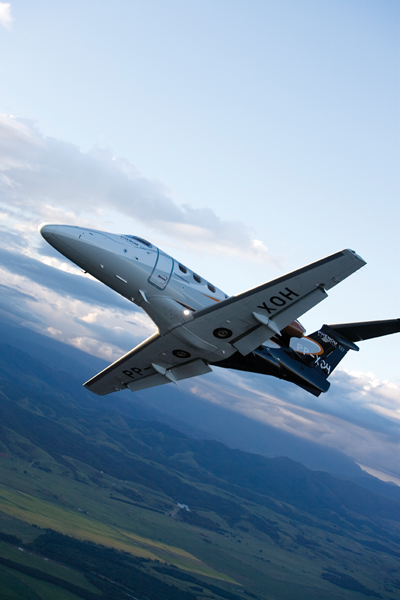 |
|
| The aircraft is capable of climbing directly to its maximum cruise altitude of 41,000 feet, even at maximum take-off weight.
|
The flight test campaign validated the Phenom 100’s top speed of 390 knots (true air speed), 10 knots faster than initially projected. The aircraft is capable of climbing directly to its maximum cruise altitude of 41,000 feet, even at maximum take-off weight.
Certified without restrictions, the Phenom can fly IFR, day or night, and into known or forecasted icing conditions. The aircraft also operates well within Stage IV external noise requirements established by ICAO.
The aircraft’s man-machine interface, based on what is called “a quiet and dark cockpit philosophy,” offers full situational awareness and automation for a low workload, contributing to its certification for single-pilot operation. The Prodigy flight deck is based on the Garmin G1000 avionics suite. It features FMS with graphical flight planning capability, integrated EICAS and main-system synoptics. Alert messages are delivered on a need-to-know basis. Three 12-inch LCDs allow for overlaying of information such as traffic and terrain for increased situational awareness.
In its normal configuration, the aircraft has a capacity of four passengers, but can carry up to six or seven passengers with a single crew, optional side facing seat and belted toilet.
The interior was designed by Embraer in collaboration with BMW Group DesignworksUSA and features, among other things, ergonomically designed seats. The cabin has an Oval Lite cross-section profile, making the interior more spacious. Its maximum height is 4 ft. 11 in., maximum width 5 ft. 1 in., length is 11 ft., and floorline width is 3 ft. 7 in.
The baggage capability totals 71 cu. ft. (2 cu. m.). In the aft fuselage, the 55 cu. ft. (1.55 cu. m.) compartment is large enough to hold skis or golf clubs. Another 5-cu.-ft. (0.14-cu.-m.) compartment is available in the forward fuselage, along with 11 cu. ft. (0.31 cu. m.) of internal pressurized storage area.
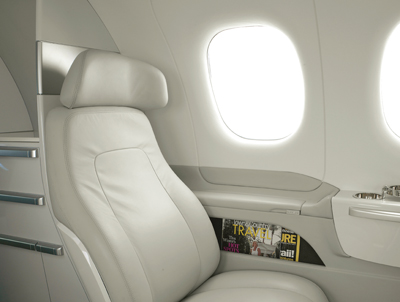 |
|
| The interior was designed by Embraer in collaboration with BMW Group DesignworksUSA and features among other things, ergonomically designed seats.
|
The Phenom 100 has long maintenance intervals (600 flight hours or 12 months) between inspections and is designed for an economic life of 35,000 cycles.
Embraer’s Executive Jets Customer Support and Services organization is well prepared for the Phenom 100. Four new Embraer Executive Jets service centres have been inaugurated in the U.S. and Europe. The entire network will eventually be comprised of seven wholly owned and 38 authorized service centres, worldwide.
In Canada, Starlink Aviation will be Embraer’s first authorized service centre for the Phenom 100 and 300. Starlink is based at Montreal’s Pierre Elliott Trudeau International Airport.
The first Phenom 100 customers were trained by the Embraer CAE Training Services joint venture, and service centre professionals have received training to perform technical and mechanical services on the Phenom 100.
A newly implemented customer contact centre has been set up and is ready and standing by to provide customers with complete and timely assistance for operational, technical and maintenance needs. Embraer’s new parts distribution centre, operated by UPS Supply Chain Solutions in Louisville, Ky., is certified, operational and stocked with a complete inventory of repairable, expendable and structural parts for the Phenom jets.
As of Jan. 5, 2009, the Phenom 100 was priced at US $3.18 million for FAA certification, and US $3.25 million for ANAC certification, both based on January 2005 economic conditions for a baseline configuration. Brought to January 2009 economic conditions, the price was US$ 3.6 million for FAA certification and US $3.68 million for ANAC and EASA certifications, subject to escalation until delivery.
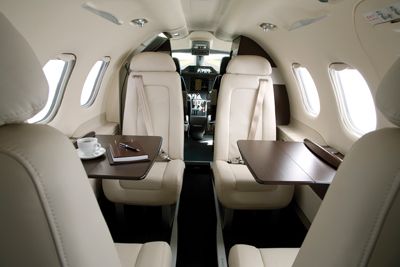 |
|
| The cabin has an Oval Lite cross-section profile, making the interior more spacious.
|
The company plans to deliver 110 Phenom 100s before the end of 2009, even though only about 20 aircraft were delivered in the first half of the year. Embraer has ramped up production to about 3.5 aircraft per week and hopes to deliver between 35 and 40 airplanes in the third quarter and the remaining 50 or so by the end of December.
The Phenom 100 made its Canadian debut at the Canadian Business Aviation Association Convention and Trade Show last May in Montreal, where it garnered a lot of interest. First deliveries into Canada are expected in the spring of 2010.
| The Engines
Model PW617F-E Compact and lightweight, the PW600 turbofan engine family is built with half the parts of a conventional turbofan, making it easy and fast to maintain. Three PW600 models are currently available (PW610F, PW615F and PW617F) ranging in thrust from 950 to 1,750 pounds. The core engine developed as a demonstrator earlier this decade has been designed to enable the PW600 family of engines to grow to 3,000 pounds thrust. The PW600 family delivers highly fuel-efficient power with low carbon emissions. It also comes equipped with dual-channel full-authority digital engine control (FADEC), which translates into reduced pilot workload and engine monitoring with longer time on wing. |